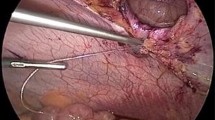Abstract
Background
Repair of large ventral/incisional (V/I) hernias is a common problem. Outside of recurrence, other factors such as wound complications and mesh infection can create significant morbidity. Chevrel described the premuscular repair and later modified it by using glue over the midline closure. We previously described our onlay technique using fibrin glue alone in a small case series. The aim of this study is to review the largest case series of sutureless onlay V/I hernia repair whereby mesh is fixated with fibrin glue alone for complex ventral hernias, and how the technique has evolved.
Methods
All patients who underwent onlay V/I hernia repair over a 3-year period were reviewed. Patient demographics, operative details, complications, and follow-up were reviewed.
Results
In total, 97 patients were included. 54.6 % were female, with a mean age of 57.3 years. Mean BMI was 32.2. 23(23.7 %) patients had diabetes. 90 (92.8 %) of the operations were for incisional hernias, 3 (3.1 %) primary ventral hernias, 2 (2.1 %) flank hernias, and 2 (2 %) complex abdominal wall reconstruction. 88 (90.7 %) of the cases were performed on an elective basis. 77 (77.3 %) cases were classified as clean, 21 (21.6 %) clean-contaminated, and 1 (1.0 %) contaminated. The mean defect size was 150 cm2. Mean follow-up was 386 days, and maximum was 3.1 years. There were 21 (21.6 %) seromas, 4 (4.1 %) wound infections, 7 (7.4 %) had skin necrosis, and 9 (9.3 %) required re-operation due to a complication. At 3 years, there have been no recurrences or mesh explants.
Conclusions
The sutureless onlay V/I hernia repair with fibrin glue fixation has proven to be durable with a comparable complication profile to other techniques. The most common sequela, seroma, is easily managed in the outpatient setting. This sutureless technique is an effective option for onlay hernia repair that may provide several advantages over traditional suture techniques.

Similar content being viewed by others
References
Chevrel JP (1979) The treatment of large midline incisional hernias by “overcoat” plasty and prothesis (author’s transl). La Nouvelle presse medicale 8(9):695–696
Chevrel JPRA (1997) The use of fibrin glues in the surgical treatment of incisional hernias. Hernia 1(1):9–14
Stoikes N, Webb D, Powell B, Voeller G (2013) Preliminary report of a sutureless onlay technique for incisional hernia repair using fibrin glue alone for mesh fixation. Am Surg 79(11):1177–1180
Kingsnorth AN, Shahid MK, Valliattu AJ, Hadden RA, Porter CS (2008) Open onlay mesh repair for major abdominal wall hernias with selective use of components separation and fibrin sealant. World J Surg 32(1):26–30. doi:10.1007/s00268-007-9287-9
Licheri S, Erdas E, Pisano G, Garau A, Ghinami E, Pomata M (2008) Chevrel technique for midline incisional hernia: still an effective procedure. Hernia 12(2):121–126. doi:10.1007/s10029-007-0288-2
Marchesi F, Pinna F, Cecchini S, Sarli L, Roncoroni L (2011) Prospective comparison of laparoscopic incisional ventral hernia repair and Chevrel technique. Surg Laparosc Endosc Percutan Tech 21(5):306–310. doi:10.1097/SLE.0b013e31822b09a4
Park AE, Roth JS, Kavic SM (2006) Abdominal wall hernia. Curr Probl Surg 43(5):326–375. doi:10.1067/j.cpsurg.2006.02.004
Williams RF, Martin DF, Mulrooney MT, Voeller GR (2008) Intraperitoneal modification of the Rives-Stoppa repair for large incisional hernias. Hernia 12(2):141–145. doi:10.1007/s10029-007-0300-x
Timmermans L, de Goede B, van Dijk SM, Kleinrensink GJ, Jeekel J, Lange JF (2014) Meta-analysis of sublay versus onlay mesh repair in incisional hernia surgery. Am J Surg 207(6):980–988. doi:10.1016/j.amjsurg.2013.08.030
Rath AM, Attali P, Dumas JL, Goldlust D, Zhang J, Chevrel JP (1996) The abdominal linea alba: an anatomo-radiologic and biomechanical study. Surg Radiol Anat 18(4):281–288
Rath AM, Zhang J, Chevrel JP (1997) The sheath of the rectus abdominis muscle: an anatomical and biomechanical study. Hernia 1(3):139–142. doi:10.1007/BF02426420
Stoikes N, Sharpe J, Tasneem H, Roan E, Paulus E, Powell B, Webb D, Handorf C, Eckstein E, Fabian T, Voeller G (2015) Biomechanical evaluation of fixation properties of fibrin glue for ventral incisional hernia repair. Hernia 19(1):161–166. doi:10.1007/s10029-013-1163-y
Birolini C, Utiyama EM, Rodrigues AJ Jr, Birolini D (2000) Elective colonic operation and prosthetic repair of incisional hernia: does contamination contraindicate abdominal wall prosthesis use? J Am Coll Surg 191(4):366–372
Carbonell AM, Criss CN, Cobb WS, Novitsky YW, Rosen MJ (2013) Outcomes of synthetic mesh in contaminated ventral hernia repairs. J Am Coll Surg 217(6):991–998. doi:10.1016/j.jamcollsurg.2013.07.382
Greenberg JJ (2010) Can infected composite mesh be salvaged? Hernia 14(6):589–592. doi:10.1007/s10029-010-0694-8
Kelly ME, Behrman SW (2002) The safety and efficacy of prosthetic hernia repair in clean-contaminated and contaminated wounds. Am Surg 68(6):524–528
Lopez-Cano M, Pereira JA, Armengol-Carrasco M (2014) Use of mesh during ventral hernia repair in clean-contaminated and contaminated cases: outcomes of 33,832 cases. Ann Surg. doi:10.1097/sla.0000000000001022
Machairas A, Liakakos T, Patapis P, Petropoulos C, Tsapralis D, Misiakos EP (2008) Prosthetic repair of incisional hernia combined with elective bowel operation. Surg J R Coll Surg Edinb Irel 6(5):274–277
Johansson M, Gunnarsson U, Strigard K (2011) Different techniques for mesh application give the same abdominal muscle strength. Hernia 15(1):65–68. doi:10.1007/s10029-010-0745-1
Acknowledgments
The authors acknowledge the University of Tennessee Health Science Center, Department of Surgery, for funding the study. We would also like to thank the clinic staff that helped make the study possible.
Author information
Authors and Affiliations
Corresponding author
Ethics declarations
Disclosures
Dr. Charles P. Shahan has no financial disclosures to report. Drs. Nathaniel Stoikes, David Webb, and Guy Voeller report consulting honoraria and research grants from Bard Inc. outside of this study. Charles P. Shahan, Nathaniel Stoikes, David Webb, and Guy Voeller have no conflicts of interest or financial ties to disclose that are directly relevant to this study.
Rights and permissions
About this article
Cite this article
Shahan, C.P., Stoikes, N. ., Webb, D. . et al. Sutureless onlay hernia repair: a review of 97 patients. Surg Endosc 30, 3256–3261 (2016). https://doi.org/10.1007/s00464-015-4647-2
Received:
Accepted:
Published:
Issue Date:
DOI: https://doi.org/10.1007/s00464-015-4647-2




